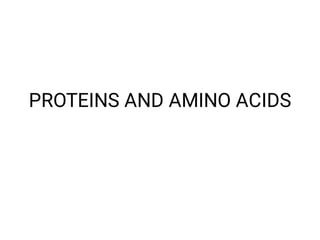
Proteins and amino acids
- 1. PROTEINS AND AMINO ACIDS
- 2. • • • • Proteins arenitrogenous “macromolecules” composed of many amino acids Proteins are macromolecules with a backbone formed by polymerization of amino acids in a polyamide structure They are the most versatile cell components Composed of C, H, O, N plus other elements such as S, I, Fe, P etc. The nitrogen content is around 16 per cent of the molecular weight of proteins.
- 3. • • • • The word protein is derived from Greek word, proteious meaning primary. So, proteins are the major components of any living organism. Proteins are natural substances with high molecular weights ranging from 5,000 to many millions. Proteins are most important constituent of cell membranes and cytoplasm. Muscle and blood plasma also contain certain specific proteins.
- 4. IMPORTANCE OF PROTEINS • Proteins are the main structural components of the cytoskeleton. • Biochemical catalysts known as enzymes are proteins. • Proteins known as immunoglobulins serve as the first line of defence against bacterial and viral infections. • Several hormones are protein in nature. • Structural proteins furnish mechanical support and some of them like actin and myosin are contractile proteins and help in the movement of muscle fibre, microvilli, etc. • Some proteins present in cell membrane, cytoplasm and nucleus of the cell act as receptors.
- 5. • The transport proteins carry out the function of transporting specific substances either across the membrane or in the body fluids. • Storage proteins bind with specific substances and store them, e.g. iron is stored as ferritin. • Few proteins are constituents of respiratory pigments and occur in electron transport chain or respiratory chain, e.g. cytochromes, hemoglobin, myoglobin. • Under certain conditions proteins can be catabolised to supply energy. • Proteins by means of exerting osmotic pressure help in maintenance of electrolyte and water balance in body.
- 6. • Protein containing foods are essential for living organism, because protein is the most important biological molecules in building up and maintenances of the structure of body.
- 7. AMINO ACIDS • • • • Proteins when hydrolyzed either by boiling with acids or through the action of enzymes, are broken down into their component amino acids. Proteins are made up from, 20 such standard amino acids in different sequences and numbers. Cells produce proteins with strikingly different properties and activities by joining the same 20 amino acids in many different combinations and sequences. This indicates that the properties of proteins are determined by the physical and chemical properties of their monomer units, the amino acids. The names of the amino acids are often abbreviated, either to three letters or to a single letter. Thus, for example, proline is abbreviated to Pro or P
- 8. Functions of Amino Acids • • Apart from being the monomeric constituents of proteins and peptides, amino acids serve variety of functions. (a) Some amino acids are converted to carbohydrates and are called as glucogenic amino acids. (b) Specific amino acids give rise to specialised products, e.g. • Tyrosine forms hormones such as thyroid hormones, (T3, T4), epinephrine and norepinephrine and a pigment called melanin. • Tryptophan can synthesise a vitamin called niacin. • Glycine, arginine and methionine synthesise creatine. • Glycine and cysteine help in synthesis of Bile salts. .
- 9. • • Glutamate, cysteine and glycine synthesise glutathione. • Histidine changes to histamine on decarboxylation. • Serotonin is formed from tryptophan. • Glycine is used for the synthesis of haem. • Pyrimidines and purines use several amino acids for their synthesis such as aspartate and glutamine for pyrimidines and glycine, aspartic acid, Glutamine and serine for purine synthesis
- 10. STRUCTURE OF AMINO ACIDS • • • All of the 20 standard amino acids, except for glycine, have four different groups arranged tetrahedrally around the C atom and thus can exist in either the D or L configuration. These two enantiomers are non superimposable mirror images that can only be distinguished on the basis of their different rotation of plane-polarized light. Only the L isomer is found in proteins. • A basic amino group (-NH2) • An acidic carboxyl group ( -COOH) • A hydrogen atom (-H) • A distinctive side chain (-R)
- 11. Classification of Amino acids • • They are frequently grouped according to the chemical nature of their side chains. Common groupings of amino acids are aliphatic, hydroxyl/sulfur, cyclic, aromatic, basic, acidic and acid amides.
- 12. 1. Biological or Physiological Classification Essential Amino Acids NON Essential Amino Acids 2. Structural Classification 3. Electrochemical classification Acidic and Basic.
- 13. • • • Essential amino acids: These are the ones which are not synthesised by the body and must be taken in diet. Non-essential amino acids: They can be synthesised by the body and may not be the requisite components of the diet. Semi-essential amino acids: These aregrowth promoting factors since they are not synthesised in sufficient quantity during growth. They include arginine and histidine . They become essential in growing children
- 15. • • Acidic amino acids: These amino acids have two –COOH groups and one – NH2 group. They are therefore monoaminodicarboxy lic acids. Aspartic acid (Asp)
- 16. • • • Basic amino acids: This class of amino acids consists of those amino acids which have one – COOH group and two – NH2 groups. Thus they arediamino monocarboxylic acids. Arginine, lysine and hydroxylysine are included in this group. Arginine (Arg)
- 17. • 1. 2. 3. 4. This is the largest group of amino acids and can be further subdivided into Aliphatic aromatic heterocyclic S-containing amino acids.
- 18. (a) Aliphatic Amino Acids (b) Aromatic Amino Acids Valine (Val) Tyrosine (Tyr) or parahydroxy phenylalanine
- 19. Heterocyclic Amino Acids Tryptophan (Trp)
